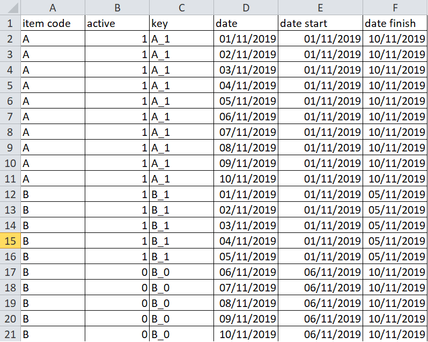- Power BI forums
- Updates
- News & Announcements
- Get Help with Power BI
- Desktop
- Service
- Report Server
- Power Query
- Mobile Apps
- Developer
- DAX Commands and Tips
- Custom Visuals Development Discussion
- Health and Life Sciences
- Power BI Spanish forums
- Translated Spanish Desktop
- Power Platform Integration - Better Together!
- Power Platform Integrations (Read-only)
- Power Platform and Dynamics 365 Integrations (Read-only)
- Training and Consulting
- Instructor Led Training
- Dashboard in a Day for Women, by Women
- Galleries
- Community Connections & How-To Videos
- COVID-19 Data Stories Gallery
- Themes Gallery
- Data Stories Gallery
- R Script Showcase
- Webinars and Video Gallery
- Quick Measures Gallery
- 2021 MSBizAppsSummit Gallery
- 2020 MSBizAppsSummit Gallery
- 2019 MSBizAppsSummit Gallery
- Events
- Ideas
- Custom Visuals Ideas
- Issues
- Issues
- Events
- Upcoming Events
- Community Blog
- Power BI Community Blog
- Custom Visuals Community Blog
- Community Support
- Community Accounts & Registration
- Using the Community
- Community Feedback
Register now to learn Fabric in free live sessions led by the best Microsoft experts. From Apr 16 to May 9, in English and Spanish.
- Power BI forums
- Forums
- Get Help with Power BI
- Desktop
- Comparaison between slicer date and data date with...
- Subscribe to RSS Feed
- Mark Topic as New
- Mark Topic as Read
- Float this Topic for Current User
- Bookmark
- Subscribe
- Printer Friendly Page
- Mark as New
- Bookmark
- Subscribe
- Mute
- Subscribe to RSS Feed
- Permalink
- Report Inappropriate Content
Comparaison between slicer date and data date with measure
Hello ,
I own set of data with 6 columns like this under power bi :
With measure and a slicer I want show in a table or matrix severals columns. The slicer must be built with the "date" column, similar to a calendar .
All columns that I want show in table/matrix of exit :
key column
date min choise in the slicer by a user
date max choise in the slicer by a user
column with start date in function of key
colum with finish date in function of key
a binary system (1 or 0) to compare the "date min choise from the slicer" with the "date start" , here the comparaison it's >/=/<
a binary system (1 or 0) to compare the "date max choise from the slicer" with the "date finish" , here the comparaison it's >/=/<
Thanks to help me to obtain only with a measure (not in column mode 😉 )
Solved! Go to Solution.
- Mark as New
- Bookmark
- Subscribe
- Mute
- Subscribe to RSS Feed
- Permalink
- Report Inappropriate Content
Hi @Anonymous ,
I create a sample that you can reference.
Date Min =
var mi = MIN('Date'[Date])
return
SWITCH(TRUE(),MAX('Table'[date start])>mi,-1,MAX('Table'[date start])=mi,0,MAX('Table'[date start])<mi,1)
Date Max =
var ma = MAX('Date'[Date])
return
SWITCH(TRUE(),MAX('Table'[date finish])>ma,-1,MAX('Table'[date finish])=ma,0,MAX('Table'[date finish])<ma,1)

Best Regards,
Xue Ding
If this post helps, then please consider Accept it as the solution to help the other members find it more quickly. Kudos are nice too.
Xue Ding
If this post helps, then please consider Accept it as the solution to help the other members find it more quickly.
- Mark as New
- Bookmark
- Subscribe
- Mute
- Subscribe to RSS Feed
- Permalink
- Report Inappropriate Content
Hello @Anonymous ,
The time intelligence features in power bi provide slicers with so much capabilities that I think you won't need a measure. I am not clear on all the columns you described. Could you provide a sample result of what you would like the table to contain, please?
Best regards,
- Mark as New
- Bookmark
- Subscribe
- Mute
- Subscribe to RSS Feed
- Permalink
- Report Inappropriate Content
Hello,
4 cases to illustrate the wanted result :
- Mark as New
- Bookmark
- Subscribe
- Mute
- Subscribe to RSS Feed
- Permalink
- Report Inappropriate Content
Hi @Anonymous ,
I create a sample that you can reference.
Date Min =
var mi = MIN('Date'[Date])
return
SWITCH(TRUE(),MAX('Table'[date start])>mi,-1,MAX('Table'[date start])=mi,0,MAX('Table'[date start])<mi,1)
Date Max =
var ma = MAX('Date'[Date])
return
SWITCH(TRUE(),MAX('Table'[date finish])>ma,-1,MAX('Table'[date finish])=ma,0,MAX('Table'[date finish])<ma,1)

Best Regards,
Xue Ding
If this post helps, then please consider Accept it as the solution to help the other members find it more quickly. Kudos are nice too.
Xue Ding
If this post helps, then please consider Accept it as the solution to help the other members find it more quickly.
- Mark as New
- Bookmark
- Subscribe
- Mute
- Subscribe to RSS Feed
- Permalink
- Report Inappropriate Content
Hello ,
Thanks for this solution , I write the formulas on my calculation .
Helpful resources

Microsoft Fabric Learn Together
Covering the world! 9:00-10:30 AM Sydney, 4:00-5:30 PM CET (Paris/Berlin), 7:00-8:30 PM Mexico City

Power BI Monthly Update - April 2024
Check out the April 2024 Power BI update to learn about new features.

| User | Count |
|---|---|
| 105 | |
| 93 | |
| 75 | |
| 62 | |
| 50 |
| User | Count |
|---|---|
| 146 | |
| 109 | |
| 106 | |
| 88 | |
| 61 |


